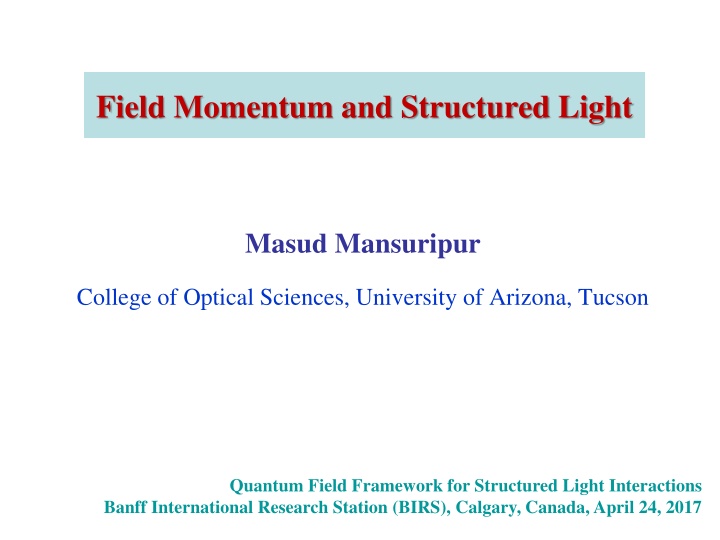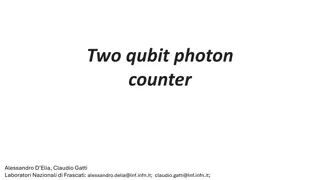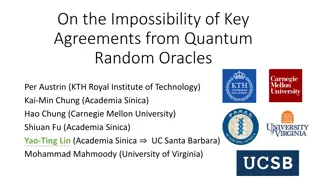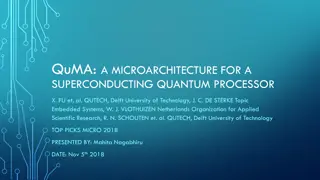Quantum Field Framework for Structured Light Interactions
In this detailed scientific discussion, explore the application of Maxwell's equations in determining electro-magnetic force and torque distributions within material media. Discover the equivalence of various stress tensors and the macroscopic equations derived by James Clerk Maxwell.
Download Presentation

Please find below an Image/Link to download the presentation.
The content on the website is provided AS IS for your information and personal use only. It may not be sold, licensed, or shared on other websites without obtaining consent from the author.If you encounter any issues during the download, it is possible that the publisher has removed the file from their server.
You are allowed to download the files provided on this website for personal or commercial use, subject to the condition that they are used lawfully. All files are the property of their respective owners.
The content on the website is provided AS IS for your information and personal use only. It may not be sold, licensed, or shared on other websites without obtaining consent from the author.
E N D
Presentation Transcript
Field Momentum and Structured Light Masud Mansuripur College of Optical Sciences, University of Arizona, Tucson Quantum Field Framework for Structured Light Interactions Banff International Research Station (BIRS), Calgary, Canada, April 24, 2017
Facts and Misconceptions Advanced applications require accurate determination of electro- magnetic (EM) force & torque distributions within material media. Material media consist of electrical charges and currents, as well as electric and magnetic dipoles. (These are known as sources. ) Maxwell s equations suffice to calculate the E and B (or H) fields. The Lorentz force law ? = ?(? + ? ?) is all we need to calculate electromagnetic force & torque distributions within material media. Electromagnetic stress tensor is all we need to calculate All EM stress tensors (Maxwell-Lorentz, Minkowski, Abraham, Chu, Einstein-Laub) are equivalent. The correct stress tensor must be consistent with conservation laws and special relativity, as well as with experimental observations. 2/14
Maxwells macroscopic equations (SI) James Clerk Maxwell (1831-1879) D = free H = Jfree+ D/ t E = B/ t B = 0 Exact equations (mathematically). No small-scale averaging required. Reducible to microscopic equations. Electric displacement D is related to polarization density P: D = oE + P = o(1+ e)E = o E Magnetic induction B is related to magnetization density M: B = oH + M = o(1+ m)H = o H free, Jfree, P, andM(r,t)are thesourcesof radiation E(r,t)and H(r,t)are the radiatedfields 3/14
P(r, t) and M(r, t) are replaced by equivalent bound-charge and bound-current densities ?e bound= ? ?(?,?) pol ?e bound = ??(?,?)/?? mag ?e bound 1? ? = ?0 ?total ?0? ? = ?free+ ?e bound mag pol ? ? = ?0?free+ ?e bound ?total + ?e bound + ?0?0??/?? ? ? = ??/?? ? ? = 0 4/14
Lorentz Force (and Torque) in the Presence of P(r, t) and M(r, t) E ? = ?(? + ? ?) V q Hendrik Lorentz (1853-1928) B F(r,t) = total(r,t)E(r,t) + Jtotal(r,t) B(r,t) Force density Charge density Current density T(r, t) = (r ro) F(r, t) Torque density Reference point Force density 5/14
Electromagnetic Energy: Poyntings Vector Image result ? ?,? = ? ?,? ? ?,? ? ? ? = ?free+ ?? ?? John Henry Poynting (1852-1914) ? ? ? = ?? ?? ? ? + ? ?0? ? + ?0? ? ?? + ? ?free+ ? ?? ?? + ? ?? ?? = 0 Field energy density Energy exchange rate between fields and media 6/14
The Stress Tensors of Lorentz, Minkowski, Abraham, Chu, and Einstein & Laub 1? ? ? ?0?? ?0 1?? ???,? = ?0? ? + ?0 ???,? = ? ? + ? ? ? ?? ?? Identical ???,? = ? ? + ? ? ? ?? ?? ?? ??,? = ?0? ? + ?0? ? ? ?0?? ?0?? ????,? = ?0? ? + ?0? ? ? ?? ?? ? ? ?,? + ??? ?,? + ?(?,?) = 0 EM momentum-density EM force-density 7/14
Electromagnetic momentum-density Maxwell-Lorentz (Livens) Momentum ???,? = ?0? ? ???,? = ? ? Minkowski Momentum ???,? = ?? ?= ???= ? ?/?2 Abraham Momentum ???,? = ???,? + ??? ? ? ?/?2 Abraham force Minkowski force-density Abraham force-density Hermann Minkowski (1864 1909) Max Abraham (1875 1922) 8/14
Electromagnetic force- and torque-density Lorentz: ???,? = ?free ? ? ? + ?free+ ??? + ?0 1? ? ? ???,? = ? ???,? Minkowski: ???,? = ?free? + ?free ? + ? ? ? + ? ? ? ?(? ?) + ? ? ? + ? ? ? ?(? ?) Hendrik Lorentz (1853-1928) ???,? = ? ???,? + ? ? + ? ? 9/14
Electromagnetic force and torque-density Image result for professor Lan Jen Chu, MIT, picture Chu: ?? ??,? = ?free ? ? ? + ?free+ ??? ?0? ? ? ? ??? ?0? Lan Jen Chu (1913-1973) ?? ??,? = ? ?? ??,? Einstein-Laub: ????,? = ?free? + ?free ?0? + ? ? ? + ??? ?0? + ? ? ? ??? ?0? Albert Einstein (1879-1955) ????,? = ? ????,? + ? ? + ? ? Jakob Laub (1884-1962) 10/14
The Balazs Thought Experiment (1953) x c E= mc2 L ( 1)L c Vg , Mo Anti-reflection coating z Agrees with Abraham momentum (Abraham, Chu, Einstein-Laub). Disagrees with Livens momentum (Maxwell-Lorentz stress tensor). Disagrees with Minkowski momentum (Minkowski stress tensor). 11/14
Ashkin-Dziedzic Experiment (Bulge on the liquid surface) Disagrees with Maxwell-Lorentz and Chu Agrees with Einstein-Laub 12/14
Hidden Momentum mo= oIoAz^ ^z + William Shockley (1910-1989) Io Point charge y Eo Shidden = M Eo/ o phidden = oM Eo + Eo x 13/14
Conclusions Maxwell s macroscopic equations are exact and self-consistent; they are also superior to microscopic equations. The Lorentz law of force is incompatible with special relativity and with the conservation laws unless hidden energy and hidden momentum are taken into account. (It also disagrees with certain experimental observations.) The correct force law appears to be that of Einstein and Laub. Electromagnetic energy flux is given by the Poynting vector ?(?,?) = ? ?. Electromagnetic momentum-density is ??(?,?) = ?(?,?)/?2 (Abraham). Electromagnetic angular-momentum-density is ? ?,? = ? ?(?,?)/?2. The above postulates are complete and consistent with Special Relativity, and with the laws of conservation of energy, momentum, and angular momentum. They also agree with the existing body of experimental observations. 14/14





